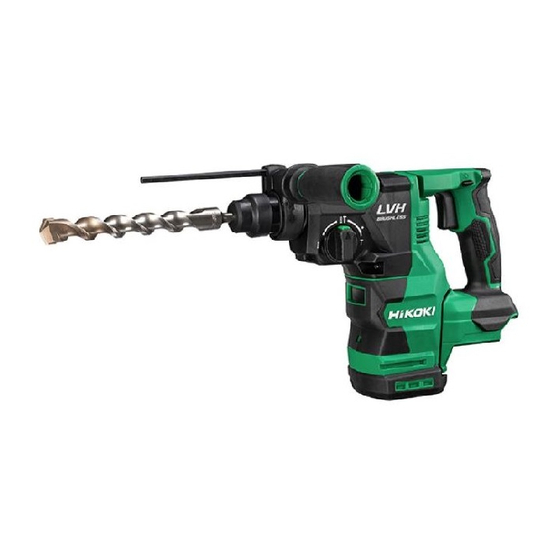HIKOKI DH 1826DC Инструкция по обращению с предметами - Страница 14
Просмотреть онлайн или скачать pdf Инструкция по обращению с предметами для Роторный молоток HIKOKI DH 1826DC. HIKOKI DH 1826DC 20 страниц.

ABOUT THE PROTECTION
FUNCTION
This tool has a built-in protection circuit for preventing
damage to the unit in the event of an abnormality.
Depending on the following, the display lamp will fl ash, and
the unit will cease to operate. Verify the problem indicated
by the fl ashing and take the necessary steps to correct the
problem.
When pressing the changeover switch, do so when the
switch is not being pulled.
Changeover switch
Display
lamp
Cause
fl ashing
Operation has
ceased because the
internal temperature
has exceeded the
temperature limit.
(High temperature
protection function)
Sudden
overburdening of
the tool bit has
activated the RFC,
stopping further
operation of the
tool.
RFC (See page 13
"REACTIVE FORCE
CONTROL")
NOTE
Despite taking steps to correct a problem, the display
lamp may continue to blink. Should this be the case, the
unit may require repair. If so, please contact the outlet
from which this product was purchased for repairs.
LUBRICATION
This Rotary Hammer is of full air-tight construction to protect
against dust.
Therefore, this Rotary Hammer can be used without
lubrication for long periods.
After purchase, periodically replace grease. Ask for grease
replacement at the nearest authorized Service Center.
CAUTION
A specifi c grease is used with this machine, therefore,
the normal performance of the machine may be badly
aff ected by use of diff erent grease. Please be sure to let
one of our service centers to undertake replacement of
the grease.
Display lamp
Fig. 24
Table 3
Solution
Allow the unit to cool
for 15 to 30 minutes.
When the temperature
goes down and the
display lamp blinking
stops, pull the switch
trigger to recover
operation.
Release the switch
trigger and leave it
until the display lamp
blinking stops. Pull the
switch trigger again to
recover operation.
Before continuing
operation, remove
the cause of the
overburden.
MAINTENANCE AND INSPECTION
WARNING
Be sure to turned off the switch and remove the battery
before maintenance and inspection.
1. Inspecting the tool
Since use of as dull tool will degrade effi ciency and
cause possible motor malfunction, sharpen or replace
the tool as soon as abrasion is noted.
2. Inspecting the mounting screws
Regularly inspect all mounting screws and ensure that
they are properly tightened. Should any of the screws be
loose, retighten them immediately. Failure to do so could
result in serious hazard.
3. Maintenance of the motor
The motor unit winding is the very "heart" of the power
tool. Exercise due care to ensure the winding does not
become damaged and/or wet with oil or water.
4. Inspection of terminals (tool and battery)
Check to make sure that swarf and dust have not
collected on the terminals.
On occasion check prior, during and after operation.
CAUTION
Remove any swarf or dust which may have collected on
the terminals.
Failure to do so may result in malfunction.
5. Cleaning on the outside
When the power tool is stained, wipe with a soft dry cloth
or a cloth moistened with soapy water. Do not use chloric
solvents, gasoline or paint thinner, for they melt plastics.
6. Cleaning the battery installation compartment and
the battery
After drilling concrete, if concrete dust has accumulated
on the battery installation compartment and the battery,
clean off the accumulated concrete dust with an air gun
or a dry cloth before using the tool. (Fig. 21)
Also, after cleaning, ensure that the battery can be
installed and removed smoothly from the tool.
CAUTION
Using the tool when the battery is covered with concrete
dust may lead to accidents such as the battery falling
during use.
Furthermore, such use may cause a malfunction or
contact failure between the battery and the terminals.
7. Storage
Store the power tool and battery in a place in which
the temperature is less than 40°C and out of reach of
children.
NOTE
Storing lithium-ion batteries.
Make sure the lithium-ion batteries have been fully
charged before storing them.
Prolonged storage (3 months or more) of batteries with
a low charge may result in performance deterioration,
signifi cantly reducing battery usage time or rendering
the batteries incapable of holding a charge.
However, signifi cantly reduced battery usage time may
be recovered by repeatedly charging and using the
batteries two to fi ve times.
If the battery usage time is extremely short despite
repeated charging and use, consider the batteries dead
and purchase new batteries.
CAUTION
In the operation and maintenance of power tools, the
safety regulations and standards prescribed in each
country must be observed.
14
